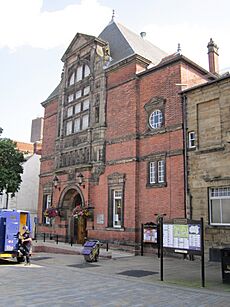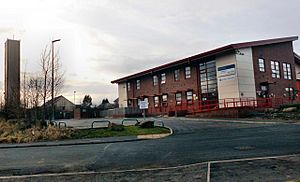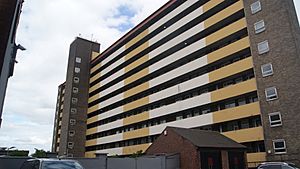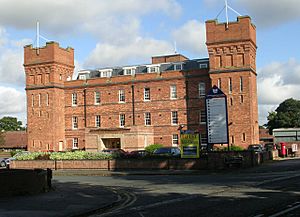Pontefract facts for kids
Quick facts for kids Pontefract |
|
|---|---|
| Town | |
 Top left, clockwise: Old Town Hall, All Saints' Church, Pontefract Castle, Market Place, The Buttercross and St Giles' Church and Pontefract Racecourse. |
|
| Population | 30,881 (North+South Wards 2011) |
| OS grid reference | SE455215 |
| • London | 257 mi (414 km) |
| Metropolitan borough | |
| Metropolitan county | |
| Region | |
| Country | England |
| Sovereign state | United Kingdom |
| Post town | PONTEFRACT |
| Postcode district | WF8 |
| Dialling code | 01977 |
| Police | West Yorkshire |
| Fire | West Yorkshire |
| Ambulance | Yorkshire |
| EU Parliament | Yorkshire and the Humber |
| UK Parliament |
|
Pontefract is a historic market town in the City of Wakefield, a metropolitan district in West Yorkshire, England. It lies to the east of Wakefield and south of Castleford. Historically part of the West Riding of Yorkshire, it is one of the towns in the City of Wakefield district and had a population of 30,881 at the 2011 Census. Pontefract's motto is Post mortem patris pro filio, Latin for "After the death of the father, support the son", a reference to the town's Royalist sympathies in the English Civil War. Small villages and settlements in the immediate area include Stapleton.
Contents
Etymology
At the end of the 11th century, the modern township of Pontefract consisted of two distinct localities, Tanshelf and Kirkby. The 11th-century historian Orderic Vitalis recorded that, in 1069, William the Conqueror travelled across Yorkshire to put down an uprising which had sacked York.
Upon his journey to the city, he discovered that a crossing of the River Aire near what is modern-day Pontefract had been blockaded by local Anglo-Scandinavian insurgents, who had broken the bridge and held the opposite bank in force. Such a crossing point would have been important to the town, providing access between Pontefract and other settlements to the north and east, such as York. Historians believe that it is this historical event which gives the township of Pontefract its modern name. The name "Pontefract" originates from the Latin for "broken bridge", formed of the elements pons (bridge) and fractus (broken). Pontefract was not recorded in the 1086 Domesday Book, but it was noted as Pontefracto in 1090, four years after the Domesday survey.
History
Neolithic
In 2007 an extension of Ferrybridge Henge – a Neolithic henge – was discovered near Pontefract during a survey in preparation for the construction of a row of houses. Once the survey was complete, construction continued.
Roman
The modern town is situated near an old Roman road (now the A639), described as the "Roman Ridge". This is believed to form part of an alternative route from Doncaster to York via Castleford and Tadcaster, as a diversion of the major Roman road Ermine Street, which may have been used to avoid having to cross the River Humber near North Ferriby during rough weather conditions over the Humber.
The period of Yorkshire's history between the demise of the Viking king, Eric Bloodaxe, in 954 and the arrival of the Normans in 1068 is known as the Anglo-Scandinavian age. The modern township of Pontefract consisted of two Anglo-Scandinavian settlements, Tanshelf and Kirkby. In Yorkshire, place-name locations often contain the distinctive Danish '-by' i.e. Kirkby and today, the major streets in Pontefract are designated by the Danish word 'gate' e.g. Bailygate.
The Anglo-Scandinavian township, Tanshelf, recorded as Tateshale, Tateshalla, Tateshalle or Tatessella in the 'Domesday Book' is today occupied by the town of Pontefract. The Anglo-Saxon Chronicle made a reference to Tanshelf in 947 when King Eadred of England met with the ruling council of Northumbria to accept its submission. King Eadred did not enjoy Northumbria's support for long, and a year later the kingdom voted Eric Bloodaxe King of York.
When the Domesday survey was commissioned by William the Conqueror in 1086, Tanshelf was a sizeable settlement. It had a priest, 60 petty burgesses, 16 cottagers, 16 villagers and 8 smallholders, amounting to 101 people. The size of the population might have been four or five times larger as the only people listed were landholders. Tanshelf had a church, a fishery and three mills. Archaeologists discovered the remains of a church on The Booths, off North Baileygate, below the castle. The oldest grave dates from around 690. The church may have been similar to the church at Ledsham. The area of the town market place was the meeting place of the Osgoldcross wapentake. In the Anglo-Saxon period part of the modern town was known by the Anglo-Scandinavian name as Kirkby.
Medieval
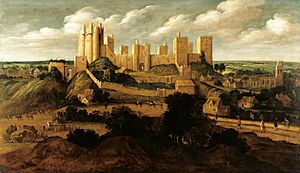
After the Norman conquest in 1066 almost all of Yorkshire came under the ownership of followers of William the Conqueror, one of whom was Ilbert de Lacy who became the owner of Tateshale (Tanshelf) where he built a castle. Pontefract Castle began as a wooden motte and bailey castle before 1086 and was later rebuilt in stone. The de Lacys lived there for more than two centuries and were holders of the castle and the Honour of Pontefract from 1067 until the death of Alice de Lacy in 1348.
King Richard II was murdered at the castle in 1400. Little is known of the nature of his demise; Shakespeare may have "adjusted" the facts for his own purposes. At least three theories attempt to explain his death: either he was starved to death by his keepers, he starved himself to death or he was murdered by Sir Piers (Peter) Exton on 14 February 1399 or 1400.
Early modern history
In Elizabethan times the castle and the town were both referred to as "Pomfret". William Shakespeare's play Richard III mentions the castle:
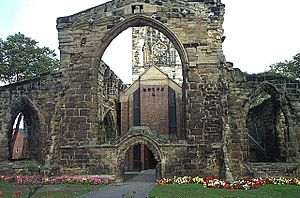
Pontefract suffered throughout the English Civil War. In 1648–49 the castle was laid siege by Oliver Cromwell, who said it was "... one of the strongest inland garrisons in the kingdom." Three sieges by the Parliamentarians left the town "impoverished and depopulated". In March 1649, after the third siege, Pontefract inhabitants, fearing a fourth, petitioned Parliament for the castle to be slighted. The castle was a magnet for trouble, and in April 1649 demolition began. The castle ruins are publicly accessible. Pontefract Priory, a Cluniac priory founded in 1090 by Robert de Lacy dedicated to St John the Evangelist was dissolved by royal authority in 1539. The priory maintained the Chartularies of St John, a collection of historic documents later discovered among family papers by Thomas Levett, the High Sheriff of Rutland, a native of Yorkshire, who gave them to Roger Dodsworth, an antiquary. They were published by the Yorkshire Archaeological Society.
Governance
For local government purposes, the town lies in the City of Wakefield and is administered by Wakefield Council. It is divided into two electoral wards, Pontefract North and Pontefract South. Pontefract South was represented by two Labour councillors and one Conservative councillor and North ward represented by three Labour councillors in 2022.
From 1978 to 1997, ex-miner and former NUM branch leader Geoff Lofthouse (18 December 1925 – 1 November 2012) was Member of Parliament (MP) for the Pontefract and Castleford constituency. During this time, he became Deputy Speaker of the House of Commons. When the general election of 1997 was called, he stood down. He was made a peer on 11 June 1997.
Yvette Cooper was elected as the MP for the Pontefract and Castleford constituency at the 1997 general election. She held a number of positions in the Labour governments up to 2010 and Shadow Cabinet roles (most notably Shadow Home Secretary) after the election of that year, but returned to the back benches after the Labour leadership election of 2015. Pontefract and Castleford was merged with the Normanton constituency in a boundary change before the 2010 general election.
The seat, which had a history of mining and industry, has returned Labour MPs at general elections. Yvette Cooper polled 59.5% of the vote in the 2017 general election and 48.1% of the vote in the 2019 general election.
Economy
Pontefract has been a market town since the Middle Ages; market days are Wednesday and Saturday, with a small market on Fridays. The covered market is open all week except Sundays. It is said by some that Pontefract once held a record for being the town with the highest number of pubs per square mile in the UK, but this is likely an urban legend, and the title is held by another town.

The town has a liquorice-sweet industry; further, the famous Pontefract cakes are produced, though the liquorice plant is no longer grown there. The town's two liquorice factories are owned by Haribo and Valeo Confectionery (formerly Tangerine). A Liquorice festival is held annually. Poet laureate Sir John Betjeman wrote a poem entitled "The Licorice Fields at Pontefract". In 2012, local farmer Robert Copley announced that he would be re-introducing a liquorice crop to Pontefract.
Close by is the site of the former coal-fired Ferrybridge power station, although the local coal mines largely closed in the 1990s, which contributed to high unemployment in the local area. The final colliery, Prince of Wales Colliery, closed in August 2002. It has since been redeveloped into a large housing estate named after the colliery.
Amenities and services
The secondary schools in the town are Carleton High School in Carleton and the King's School on Mill Hill Lane, both for pupils aged 11–16. A sixth-form college, New College, Pontefract, is located on Park Lane.
..... Beneath this building is an old hermitage, open to the public on certain days. Pontefract Museum, from which the hermitage schedule can be obtained, is in the town centre, housed in the former Carnegie library.
A new hospital was built on Friarwood Lane and opened in July 2010, with the new name of Pontefract Hospital; there is now a modern hospital building. Near to the hospital is Friarwood Valley Gardens, a rose garden, a sensory garden, a pinhole camera (formerly an aviary and earlier a Georgian gambling den) and an avenue of cherry trees.
The local police force is West Yorkshire Police, with the town's neighbourhood policing team situated at the new fire station on Stumpcross Lane. The original police station in Sessions House Yard has been demolished since the divisional headquarters for the Wakefield District opened in Normanton and the neighbouring magistrates' court has moved to Leeds, following the closure of the Wakefield and Pontefract courts.
Fire cover is provided by West Yorkshire Fire and Rescue Service, with one pump (sometimes two) based at Pontefract Fire Station. Formerly located on Stuart Road in the town centre, the station has moved to a new site at Stumpcross Lane, by the A645 at the town's eastern edge. The new fire station provides cover for Knottingley; that town's fire station having been closed as part of the merging of fire cover for Pontefract and Knottingley.
Ambulance cover is provided by Yorkshire Ambulance service, whose depot is situated in neighbouring town, Castleford.
The Territorial Army, Army Cadets and Air Training Corps all have a presence within the town and are based at the historic Barracks building on Wakefield Road. It now houses a Rifles Regiment Recruitment team.
Media, arts and entertainment
Local news and television programmes are provided by BBC Yorkshire and ITV Yorkshire. Television signals are received from the Emley Moor TV transmitter.
Local radio stations are BBC Radio Leeds on 92.4 FM, Greatest Hits Radio Yorkshire (formerly Ridings FM) on 106.8 FM, Heart Yorkshire on 106.2 FM, Hits Radio West Yorkshire (formerly Pulse 1) on 102.5 FM, Capital Yorkshire on 105.1 FM and 5 Towns FM, a community online radio station that broadcasts from Castleford.
The local newspaper is the Pontefract and Castleford Express.
Novelist Jack Vance, in the "Demon Princes" cycle has named the capital of Aloysius, the main planet in the Vega system, after Pontefract. The hero of the series, Kirth Gersen, has his residence there.
Pontefract made local and national newspapers in April 2020, with a range of art which lay tribute to the key workers and NHS during the coronavirus outbreak. The art was painted by a local mural artist, Rachel List.
Sport
The town is home to many sports including rugby, football and squash. Prominent squash players Lee Beachill and James Willstrop both train at Pontefract Squash Club. Notable institutions are horse racing at Pontefract Racecourse and Featherstone Rovers, the area's professional rugby league club.
Pontefract Racecourse is the longest continuous horse racing circuit in Europe at 2 miles 125 yards (3,333 m; 16.57 furlongs). It stages flat racing between the end of March and the end of October. A new sports centre is located at Pontefract Park which opened on 12 April 2021, which replaces the old swimming pool located on Stuart Road. Two-time European Masters Champion weightlifter Martyn Riley is from Pontefract.
Pontefract has its own non-league football club, Pontefract Collieries F.C., which was founded in 1958 and plays adjacent to the former Prince of Wales Colliery off Beechnut Lane. The team, known locally as "Ponte Colls" play in the Northern Premier League Division One North West (correct as of the 2021–22 season). Pontefract is also home to the Pontefract Knights rugby league football club.
Pontefract RUFC is based at Moor Lane, Carleton. It runs three senior sides as well as a number of junior and girls teams. Rugby Union has been played in the town since the 19th century when Pontefract won the Yorkshire Cup.
Pontefract used to boast two cricket clubs, Lakeside CC (based in Pontefract Park) and Pontefract CC (adjacent to Pontefract Collieries FC), but by 2002 neither of these clubs were still in existence, leaving the town without its own club despite giving its name to the Pontefract and District Cricket League. Nowadays cricketers must travel to clubs in neighbouring towns and villages, with the closest being Hundhill Hall Cricket Club based in the nearby village East Hardwick.
Transport
Pontefract lies in close proximity to the A1 and the M62. Access from the A1 is via a junction at the nearby village of Darrington, while access from the M62 is via Junction 32 (also for Castleford) and Junction 33 (also for Knottingley).
Bus transport is provided by Arriva Yorkshire, operating from Pontefract bus station as the town's main hub.
There are three railway stations in the town. Pontefract Baghill is on the Dearne Valley Line, which connects York and Sheffield. Pontefract Monkhill and Pontefract Tanshelf connect with Leeds, Wakefield Westgate and Wakefield Kirkgate. There are rail services from Bradford Interchange to London that stop at Pontefract Monkhill.
The closest airport is Leeds Bradford.
Notable people
- Darren Appleton (1976–) Professional pool player, 9 ball world champion, 10 ball world champion.
- Thurstan of Bayeux, (c.1071–1140), archbishop, died in Pontefract.
- Richard de Pontefract (?–1320?), Dominican friar
- John Ramsden (1594–1646), High Sheriff of Yorkshire, MP for Pontefract in the Short Parliament, and Royalist soldier
- John Jackson (1595?–1637), MP for Pontefract during the Happy Parliament
- Francis Drake (1696–1771), antiquary and surgeon
- Robert Monckton, (1726–1782), MP for Pontefract and British army general
- John Smyth (1748–1811), MP for Pontefract
- Jesse Hartley (1780–1860), civil engineer and Superintendent of the Concerns of the Dock Estate, Liverpool; built the Albert Dock and many other parts of Liverpool Docks
- Charles Coleman (1807–1874), English painter
- Isaac Cole (1886–1940), rugby union and league player who represented England
- Edward Upward (1903–2009), novelist, lived in Pontefract from 2004 until his death in 2009
- Barbara Castle (1910–2002), Labour Party politician
- John Poulson (1910–1993), architectural designer and businessman
- Don Robinson (1932–2017), 1954 Rugby League World Cup winning rugby league footballer who represented Great Britain, Wakefield Trinity, Leeds, and Doncaster
- Mal Kirk (1936–1987), wrestler
- Margaret Drabble (1939–), novelist, was evacuated to Pontefract during WW2
- Harvey Proctor (1947–), Conservative Member of Parliament
- Mick Jackson (1947–), musician, writer of "Blame It on the Boogie"
- Kevin Moreton (1959–), actor known for Coronation Street
- Jane Collins (1962–), politician, UKIP, Brexit Party MEP Yorkshire (2014–2019)
- Paul Crichton (1968–), former footballer who currently serves as the goalkeeping coach for Huddersfield Town
- Helen Baxendale (1970–), actress known for Cold Feet, Friends, and Cuckoo
- Paul Newlove (1971–), English rugby league footballer who played in the 1980s, 1990s, and 2000s
- Dave Smith (1971–), professional darts player from Knottingley, Wakefield, West Yorkshire
- Robert Hanby (1974–), former footballer
- Dexter Tucker (1975–), footballer
- Chris Silverwood (1975–), cricketer who represented Yorkshire, Middlesex, and England. Former coach of the England Men's Cricket team
- Jamie Davis (1981–), actor best known for his roles in Footballers' Wives, Hex, and currently in Casualty as Max Walker
- Rob Burrow (1982–2024), former rugby league footballer with Leeds; he also has represented both England and Great Britain
- Toby Kebbell (1982–) actor known for "Black Mirror", "RocknRolla", "Dawn of the Planet of the Apes", "Warcraft", and "Kong: Skull Island"
- Jamie McCombe, (1983–), footballer who currently plays for Doncaster Rovers
- Paul Green (1983–), footballer who plays for Oldham in the English Football League
- James Willstrop (1983–) squash player and gentleman. Attended Ackworth School and in 2012 became World No.1 in squash by beating David Palmer.
- Tim Bresnan (1985–), cricketer who represented Yorkshire, Warwickshire and England
- Ben Parker (1987–), former footballer who played for Leeds United and represented England U19
- Oliver Hindle (1988–), artist and musician, best known for his band project Superpowerless
- Max Litchfield (1995–), swimmer, silver medallist in the 400m medley at the European Long Course Championships
- Joe Litchfield (1998–), swimmer and brother of Max
- Joe Westerman, rugby league footballer
- Dr Harold Shipman spent some time working here.
See also
 In Spanish: Pontefract para niños
In Spanish: Pontefract para niños
 | Misty Copeland |
 | Raven Wilkinson |
 | Debra Austin |
 | Aesha Ash |




